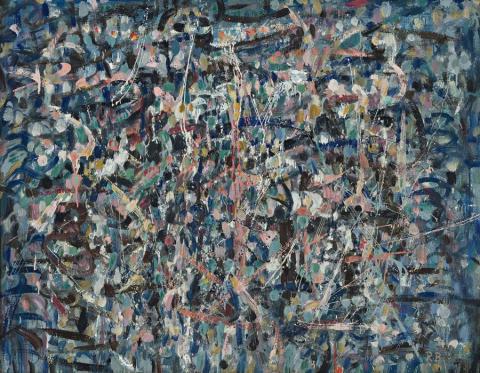NON-OBJECTIVE PAINTING, 1959
Ralph Balson
enamel on hardboard
86.0 x 109.0 cm
signed lower right: R Balson
Niagara Galleries, Melbourne, 1987
Private collection, London
Ralph Balson, a rightly revered pioneer of abstract art in Australian, wrote in 1956, '...maybe the ultimate goal of all the arts is the ineffable.'1
To recognize the arts, and painting in particular as being beyond description, is surely the first step in understanding and enjoyment. For while we can define the qualities and characteristics of Balson's art in terms of the beauty of its formal elements- of paint and colour - and note the expression of serenity touching upon the infinite, paradoxically, the paintings remain entirely themselves, marvellously free of outside association. By 1956 Balson's geometrically inclined Constructive paintings had given way to painterly abstraction, the style that occupied him until about 1960. Daniel Thomas hailed it as 'the climax of his career.'2 As a group, these paintings were generally known as 'Non- Objective Abstracts', usually titled, as in our work, 'Non-Objective Painting'. This splendidly enriching painting has a freedom of expression that belies its very considered technique - for example, the density of the brushstrokes in the body of the painting, which become looser and more open towards the edges. Working within in its own spatial depth, it is characteristically full of energy and flux, possessing a new grandeur found in such related examples as Non-Objective Painting, 1959, in the collection of the National Gallery of Australia, Canberra, and Painting No 9 also of 1959 in the Art Gallery of New South Wales. The latter was included in two important exhibitions of the time- Recent Australian Painting, Whitechapel Gallery, London in 1961, and Balson, Crowley, Fizelle, Hinder, a scholarly and absorbing presentation of Sydney's pioneer abstractionists at the Art Gallery of New South Wales in 1966. In Balson's 'Matter Paintings' of his final phase he poured his paint to give it even greater freedom, to speak more for its self.
'In my painting the matter, the paint, was allowed to flow together to produce its own rhythm, its own structure - a natural paint structure.'3 Balson returned to Non-Objective Abstraction in his last paintings, showing 'greater resonance of movement and colour than ever before...'4 They touch upon that same sense of universal order that we can see in our painting.
1. Pacific Loan Exhibition catalogue, quoted in Thomas, D[aniel], 'Ralph Balson', Art and Australia, vol.2, no.4, Sydney, March 1965, p. 258
2. Thomas, ibid., p. 248
3. Ralph Balson letter to Art Gallery of New South Wales, 1962, quoted in Thomas, op. cit., p. 290
4. Thomas, ibid.
DAVID THOMAS
